If you’ve only ever bought garlic from the grocery store, chances are you’ve tried one or two types of garlic and may have thought that’s all there is.
But venture out into growing your own garlic at home, and you’ll find dozens of varieties that range from mild to hot, white to purple, and everything in between, with each one differing in flavor far more than you’d think.
Many gardeners are surprised by the sheer number of garlic varieties available for planting, and choosing the right one for your growing conditions and personal taste can be tricky.
You may have even heard a couple of terms thrown around, like hardneck and softneck, but what do they really mean? And can you plant just about any garlic in your climate?
Below, I’ll help you unmuddy the waters to find the best kind of garlic to grow in your area.

How many garlic varieties are out there?
True garlic (Allium sativum) is commonly divided into two subspecies: softneck and hardneck.
Then there are are 2 groupings of softneck garlic and 8 groupings of hardneck garlic, totaling 10 major groups of garlic.
Within each group are various named strains (cultivars), adding up to roughly 600 cultivars that currently exist in the world (with about 120 of them originating in Central Asia, making that region the epicenter of garlic biodiversity).
But in the United States, we usually see far less than that in our garden catalogs, and the garlic we do have access to for home cultivation are somewhat climate-specific.
If you’re in the south, for example, you won’t be able to grow hardneck garlic that’s bred for northern climates.
The good news is you can grow several different varieties of garlic each season (even mixing softneck and hardneck types if you’re in the right climate) and they won’t cross-pollinate.
| Softneck types | Hardneck types |
|---|---|
| Artichoke | Purple stripe |
| Silverskin | Glazed purple stripe |
| Marbled purple stripe | |
| Porcelain | |
| Rocambole | |
| Creole | |
| Asiatic | |
| Turban |
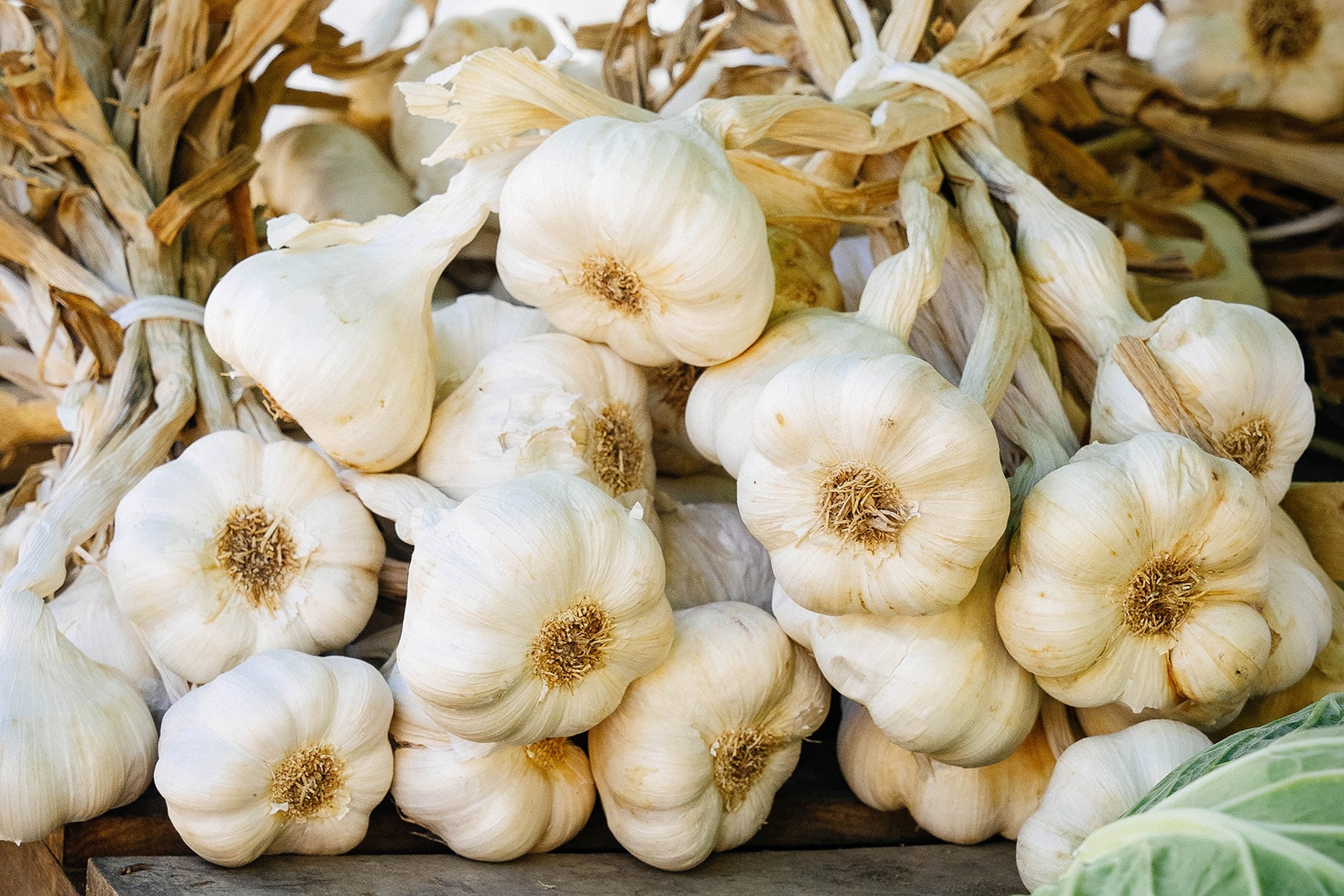
Softneck garlic varieties
First, let’s talk softneck garlic (Allium sativum var. sativum).
Whether you knew that’s what they’re called or not, softneck garlic is most familiar to everyone because you’ve been eating it your whole life.
The two most common kinds of garlic sold in supermarkets—whether they came from Gilroy, California, or China or wherever—are both softneck varieties.
Softneck garlic is named for its soft, braidable stems (famously hung from many an Italian restaurant) and is sometimes called braiding garlic because of that characteristic.
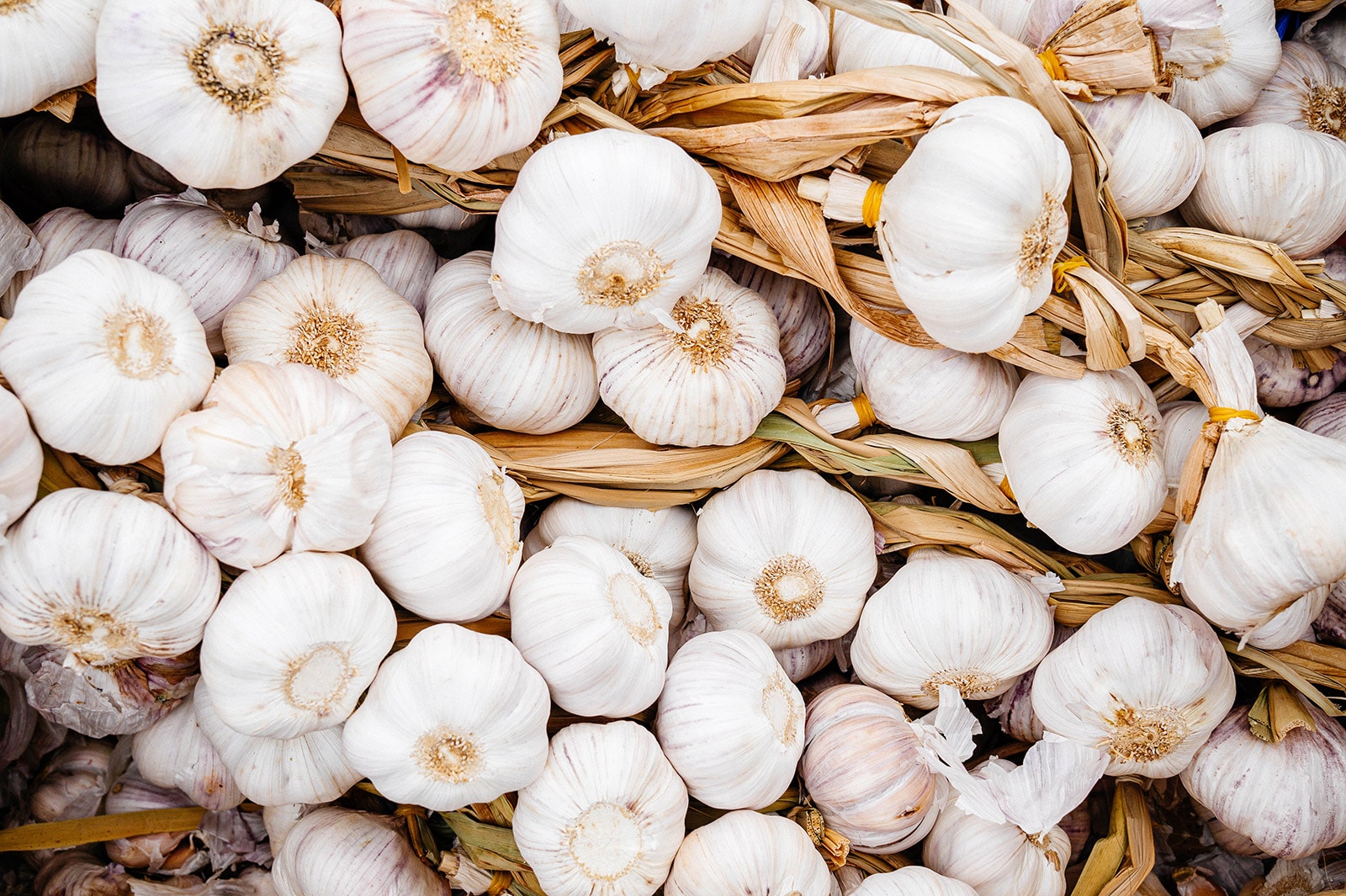
The softneck type was originally selected from hardneck garlic. The cloves tend to be either hot and aggressive (as with Silverskins) or mild and almost vegetable-like in flavor (as with the Artichoke group).
Compared to the exciting array of garlic out there, softneck varieties tend to lack the complexity and heat of hardneck types.
Size-wise, softneck bulbs have smaller cloves than hardneck types. But don’t that let fool you—it’s not uncommon to see bulbs up to 3 inches across, which means they produce up to twice as many cloves per bulb, all arranged in multiple layers with the smallest cloves clustered in the center.
This means there are more plantable cloves per bulb—which is great for gardeners—but since they’re harder to peel, not so great for home cooks who may find them tedious when making a big meal calling for lots of garlic.
Softneck garlics mature quicker than hardnecks and don’t require any effort mid-season to harvest scapes (the central flowering stalk on hardneck garlic). They can also be planted mechanically and have a longer shelf life, so they’re the preferred type for growing commercially.
Under optimal conditions, softneck garlic can sometimes store for up to a year after harvest!
Read next: The Ultimate Guide to Harvesting, Curing, and Storing Garlic
They’re best suited to warmer climates, USDA zones 5 and above.
You’ll find two groups in this subspecies:
Artichoke
Artichoke softneck varieties are the most domesticated of all garlics, and for good reason: They produce reliably large bulbs and have a simple savory flavor that no one can complain about.
This group of garlic is named for their overlapping layers of cloves that resemble the structure of an artichoke. A typical bulb yields 12 to 20 cloves in 3 to 5 layers.
If you want to try something new, you can’t go wrong with Inchelium Red, Lorz Italian, Sicilian, California Early, or Transylvanian.
Silverskin
Though Silverskins are among the latest maturing of all the garlic varieties, they’re also tolerant of a wide range of growing conditions and are quite productive.
They’re a great choice for spring-planted garlic if you want a variety that’s more apt to produce decent-sized bulbs by summer. The average bulb has 12 to 20 cloves.
Popular selections include Nootka Rose, Silver White, Sicilian Silver, Mild French, and Mexican Red.
Softneck garlic comparison chart
Note: On mobile devices, comparison chart scrolls to the right.
| Variety | Climate | Maturity | Storage Months | Flavor | Cloves/bulb | Cloves/lb | Bulbs/lb |
|---|---|---|---|---|---|---|---|
| Artichoke | Cool to hot, versatile | Early | 8 to 10 | Mild | 12 to 20 | 65 | 5 to 10 |
| Silverskin | Cold to hot, versatile | Late | 12 | Hot | 12 to 20 | 70 | 3 to 6 |
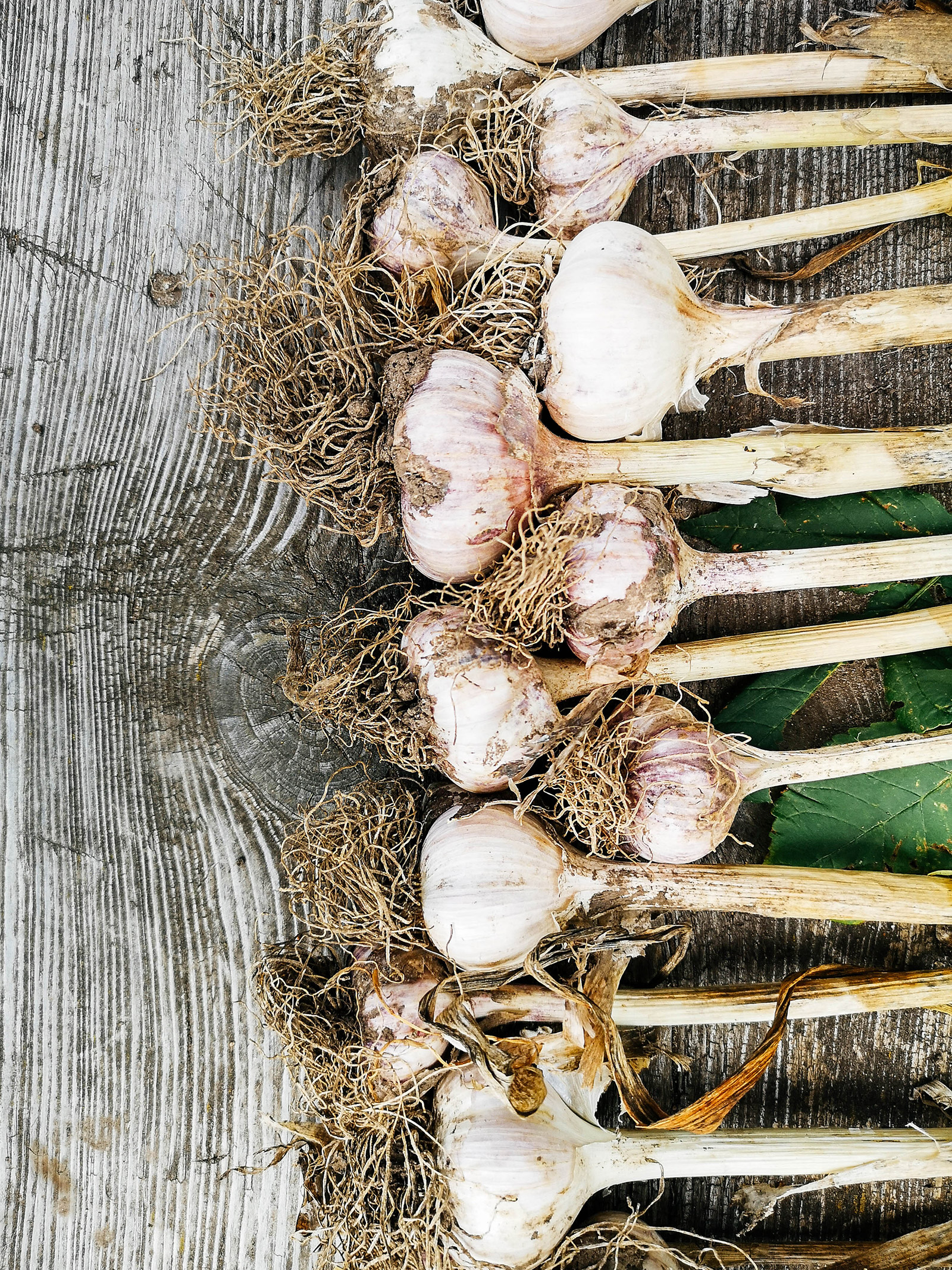
Hardneck garlic varieties
Hardneck garlic (Allium sativum var. ophioscorodon) is named for the stiff, central flower stalk that forms above the leaves in late spring to early summer.
This stalk is called a garlic scape, and it’s a bonus vegetable you can pick before the crop matures. (Picking the scape also allows the plant to devote more energy into growing the bulb, resulting in larger bulbs.)
Related: How to Harvest Garlic Scapes (+ 8 Easy Ways to Use Them!)
If you grow hardneck garlic at home, you might be surprised to find what looks like baby garlic appearing on the flower stalks as the crop matures.
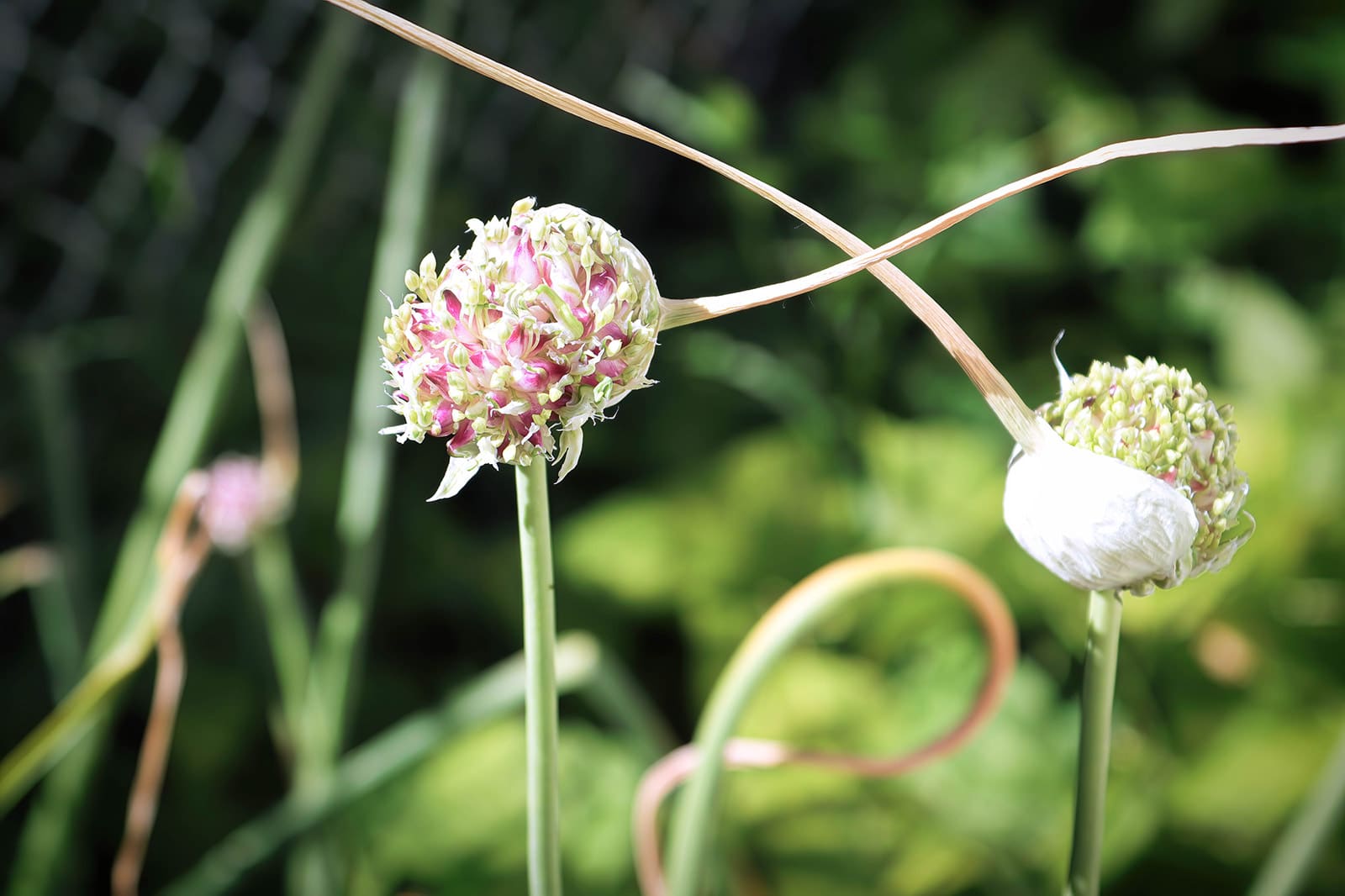

These mini cloves are called bulbils, and they’re essentially divisions of the parent plant as they’re genetically identical. This means the bulbils aren’t true garlic seeds (though they may look like it)—the plant you end up with if you sow the bulbil would be a clone of the original.
But growing garlic from bulbils isn’t ideal for most gardeners because it takes a much longer time from seed to harvest (anywhere from two to five years, depending on the cultivar).
Therefore, bulbils are best used as tiny cloves of garlic. They don’t have to be peeled and can simply be crushed or used whole in recipes like any other garlic.
In general, hardneck garlic varieties have better flavor than softnecks and also outperform them in colder climates, making them the preferred type for northern gardeners.
They’re exceptionally cold hardy, even in severe winter areas. With proper planting and care, hardneck garlic can even be grown in USDA zone zero! Brrrr!
The bulbs have large cloves that develop in a single row and are easy to peel, though larger cloves also mean fewer “seed” garlic per pound at planting time.
There are eight recognized groups of hardneck garlic, though three of them (which I note below) are weakly bolting hardnecks that often produce softnecks in warmer climates:
Purple Stripe
I’ll begin with Purple Stripes because they are considered to be the granddaddy of all garlics.
As the most ancient group of garlic, Purple Stripes are beautiful bulbs with vividly colored wrappers dappled in purple.
They typically have 8 to 12 cloves per bulb and are easy to grow, though they tend to mature later in the season than other types of garlic.
Chesnok Red and Persian Star are the gold standard of this type, with Red Grain, Shatili, and Siberian also being popular selections.
Glazed Purple Stripe
Both Glazed Purple Stripes and Marbled Purple Stripes were once considered subtypes of standard Purple Stripes, but are now their own unique strains.
This type of garlic is fairly hardy and not particularly fussy, though it does have delicate wrappers that require careful handling during harvest.
The average bulb yields 8 to 10 cloves.
Purple Glazer, Vekak, Brown Tempest, Blanak, and Red Rezan are popular varieties in this group.
Marbled Purple Stripe
This type of hardneck garlic has more plantable cloves than Porcelains but fewer, fatter cloves than the standard Purple Stripes. You’ll usually get six to eight large cloves per bulb.
While the wrappers are stunning with their purple-streaked patterns, the cloves themselves are more on the brown side. This garlic does well under a wide variety of conditions, making it nearly foolproof for home growing.
When ordering a Marbled Purple Stripe, you’ll likely come across Khabar, Wenger’s Russian, Belarus, Northern Siberian, and Metechi.
Porcelain
This is considered the hardiest type of hardneck garlic and is highly recommended for novice gardeners in cold climates. They’re big, beautiful bulbs with satiny white wrappers, and have a strong flavor.
Don’t be surprised if you sometimes see only two cloves on a single head of garlic, though the average yield is four to five cloves per bulb.
Music is an ever popular selection in this group (and one of my personal favorites that I grow every year). You’ll also commonly find Leningrad, Rasa Blanca, Great Northern, and Majestic from garlic seed suppliers.
Rocambole
Considered to have the best and truest flavor of all the garlics, Rocamboles are robust and rich in character with a buttery aroma.
Favored by gourmet chefs, this highly coveted garlic is not the easiest to grow but well worth the effort.
Each bulb has 8 to 12 cloves, with loose, reddish-brown skins that make them easy to peel.
Popular selections include Spanish Roja, Killarney Red, Island Rocambole, Klamath Wild, and Martin’s Heirloom.
Creole
As one of the three weakly bolting hardneck types, Creoles sometimes develop without scapes, making them more akin to softnecks.
They thrive in hot, dry climates and are heavily influenced by weather fluctuations, so they’re best suited for zones with year-round consistent temperatures.
This was my go-to garlic when I lived in Southern California, as it produced very well with great flavor. Since I was in USDA zone 10b, my Creole garlic never developed scapes.
An average bulb yields anywhere from 4 to 12 cloves.
Look for Ajo Rojo, Creole Red, Cuban Purple, Burgundy, or Pescadero Red when ordering Creoles.
Asiatic
Another weakly bolting hardneck, Asiatic garlics won’t form scapes in warmer climates. But if they do appear, Asiatics differ from other hardnecks in that the scapes can be left on the plants without affecting final bulb size.
They’re generally easy to grow and mature significantly faster than most other garlic types—often weeks ahead.
Popular selections include Asian Tempest, Korean Red, Korean Mountain, Japanese, and Russian Redstreak.
Turban
This weakly bolting hardneck garlic is an excellent choice for gardeners with short growing seasons, as it’s one of the earliest garlics to be harvested.
However, it also does well in hot climates, making it a fairly versatile variety. It produces large, plump bulbs with bright white wrappers covered in purple striping.
A typical bulb yields 6 to 10 cloves.
Try Basque, Uzbek, Thai Purple, China Stripe, or Lotus if you often have trouble getting your garlic crop to mature on time.
Hardneck garlic comparison chart
Note: On mobile devices, comparison chart scrolls to the right.
| Variety | Climate | Maturity | Storage Months | Flavor | Cloves/bulb | Cloves/lb | Bulbs/lb |
|---|---|---|---|---|---|---|---|
| Purple Stripe | Cold winters | Mid | 6 | Full, great roasted | 8 to 12 | 55 | 4 to 7 |
| Glazed Purple Stripe | Cold winters | Mid | 6 | Full, great roasted | 6 to 10 | 55 | 4 to 7 |
| Marbled Purple Stripe | Cold to cool winters | Early | 6 | Full, great roasted | 6 to 10 | 55 | 4 to 7 |
| Porcelain | Cold winters | Late | 8 to 10 | Hot | 4 to 6 | 40 | 4 to 6 |
| Rocambole | Cold winters | Late | 6 | Rich, robust | 6 to 11 | 60 | 5 to 10 |
| Creole | Hot, humid, southern | Mid | 12 | Spicy, sweet | 8 to 12 | 75 | 6 to 9 |
| Asiatic | Mild, southern | Early | 3 to 5 | Hot | 4 to 7 | 45 | 6 to 11 |
| Turban | Mild, southern | Very early | 3 to 5 | Hot | 6 to 8 | 60 | 7 to 10 |
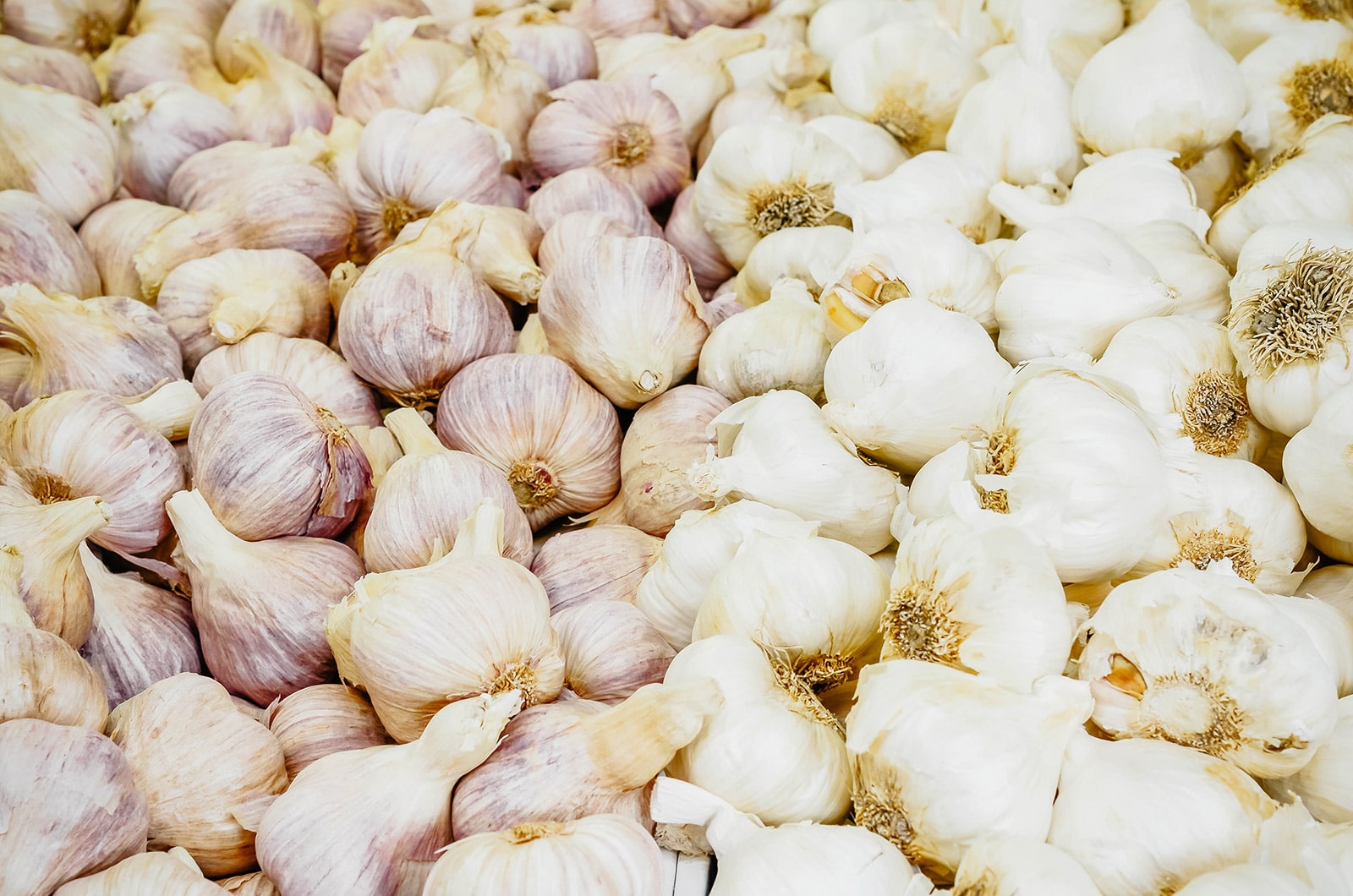
Elephant garlic
I put elephant garlic on the list even though it’s not a true garlic—it’s a member of the leek family.
But people who don’t love the intense flavor of garlic tend to like elephant garlic (Allium ampeloprasum) because of its very mild, almost sweet taste, especially after roasting (a popular way to prepare the whole bulb).
With its whopping size (double that of true garlic), elephant garlic has huge cloves that are super easy to separate. This makes it convenient for not only planting but cooking as well, since they peel with minimal effort.
Elephant garlic grows like regular garlic, forming a bulb underground that divides into five or six cloves. It even sends up a hardneck scape in late spring that can be picked and eaten.
If planted in fall, elephant garlic matures at the same time as other garlic (between May and July). You can also plant in spring for a harvest in 90 days.
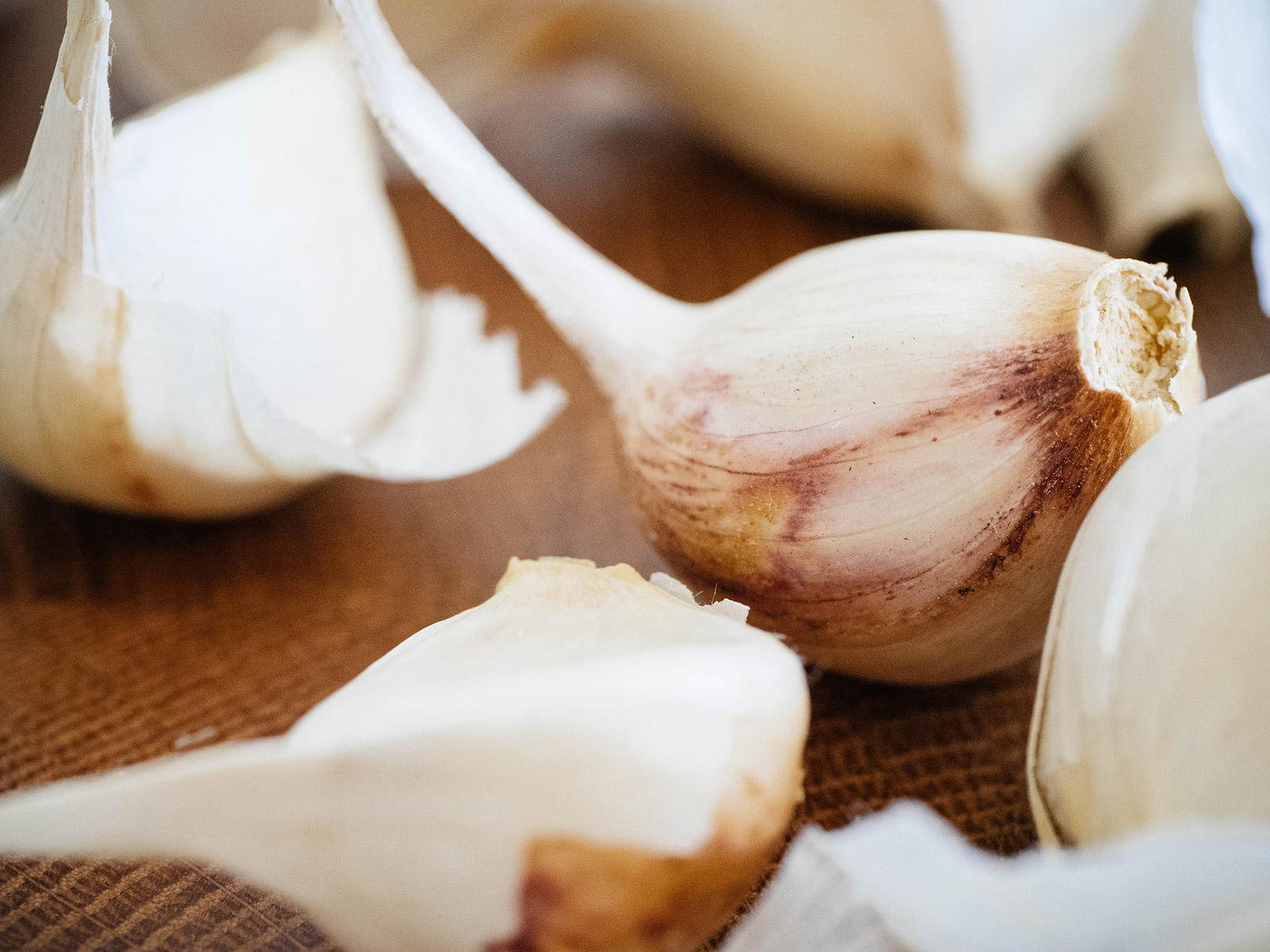
The best garlic varieties to plant
When it comes to growing garlic, knowing what’s available is only half of it. The most important part is finding the best varieties for your garden, and much of it depends on your climate and location.
If you live in a mild climate that doesn’t get hard freezes in winter, go for softneck garlic. This type of garlic does well in USDA zones 5 and above, making it fairly versatile.
If your winters are very cold, choose a hardneck garlic, which flourishes in zones 4 and below. Not only will you have more success in a shorter growing season, you’ll also benefit from the longer storage life of hardneck garlic and what many people consider a better flavor too.
Climates that fall in the middle of the road can even try both types of garlic.
There’s no reason you can’t have different varieties growing side by side, and if you choose carefully, you can harvest your garlic crop over a period of several weeks, as each variety matures at a different rate.
Related: Find First and Last Frost Dates Accurately with This Custom Planting Calendar
Set some fresh garlic aside to eat immediately (especially those with a shorter shelf life) and cure the rest for long-term storage.
The biggest cloves can be saved separately to use as seed garlic in fall.
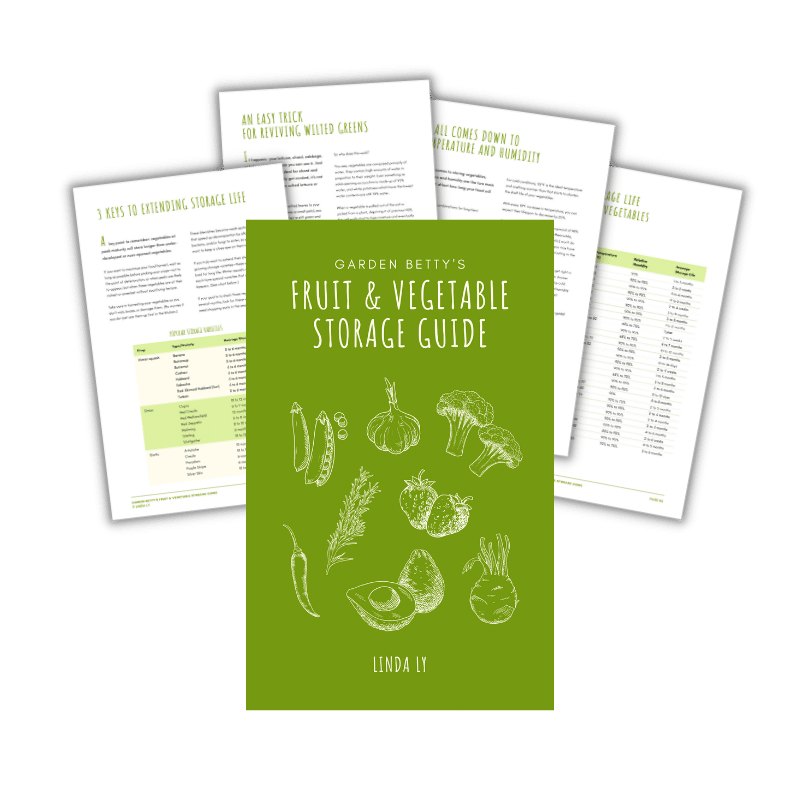
Don’t let good food go to waste!
Download my Fruit & Vegetable Storage Guide for printable charts, helpful tips, and secret tricks for keeping your produce super fresh for as long as possible.
The great thing about garlic is that it adapts well to your growing conditions, so if you continue to save your own garlic seed year after year, your crop and harvest will only get better.
Read more: How to Save and Store Seeds for Next Year’s Garden
This is generally why I prefer growing garlic varieties that have large cloves: not only are they easier to cook with, but they often produce larger bulbs.
What size garlic clove is best for planting?
So how small is too small? What size garlic cloves should you aim to save?
The answer depends on the cultivar.
First, I only look at garlic bulbs that are at least 2 inches in diameter. Anything smaller than that is destined for the kitchen. (If none of your garlic passes this test, then I recommend purchasing new seed garlic. I’ve provided a list of suppliers below.)
From that 2-inch (or larger) bulb, I save the biggest of the outermost layer of garlic cloves. If the clove is quick and easy to peel by hand, then it’s usually big enough to plant.
Sometimes all the cloves in a head of garlic will be plantable (as is the case with Music garlic, for instance), and sometimes you’ll only get three to five good plump ones from each bulb.
Once you separate the cloves, save the large ones in a paper bag for planting in the fall, and use up the remaining cloves first (before you dive into your stored garlic).
Disclosure: If you shop from my article or make a purchase through one of my links, I may receive commissions on some of the products I recommend.
Where to buy garlic seed
The best places to find garlic seed include:
- Your own garlic harvest (save the biggest bulbs for planting!)
- Farmers’ markets (you’re more likely to find organic or unsprayed garlic from a local farm)
- Garden center or nursery (check stores in late summer to early fall)
- Garden seed catalogs (some seed suppliers carry a limited stock of garlic in spring)
You can also order garlic online. Most garlic growers and seed suppliers take pre-orders from spring through early summer, and then ship in fall. So plan ahead if you want the greatest variety of seed garlic to choose from!
- Botanical Interests (Broomfield, CO)
- Filaree Farm (Okanogan Valley, WA)
- Garlic Gods (Heyburn, ID)
- Grá Den Talún Farm (Eagle Bridge, NY)
- Gurney’s Seed & Nursery Company (Greendale, IN)
- Hudson Valley Seed Company (Accord, NY)
- Keene Garlic (Madison, WI)
- Peaceful Valley Farm & Garden Supply (Grass Valley, CA)
- Perkins’ Good Earth Farm (DeMotte, IN)
- Seed Savers Exchange (Decorah, IA)
- The Garlic Store (Fort Collins, CO)
More garlic posts to help you this year:
- Get Your Garlic On: Planting and Growing Garlic the Easy Way
- Stop Garlic Rust Before It Starts (and What to Do If It’s Too Late)
- How to Grow, Harvest, and Use Green Garlic In Spring
- The Trick of Knowing When to Harvest Garlic
- How to Harvest Garlic Scapes (+ 8 Easy Ways to Use Them!)
- The Ultimate Guide to Harvesting, Curing, and Storing Garlic
This post updated from an article that originally appeared on June 22, 2022.
View the Web Story on the best garlic varieties.


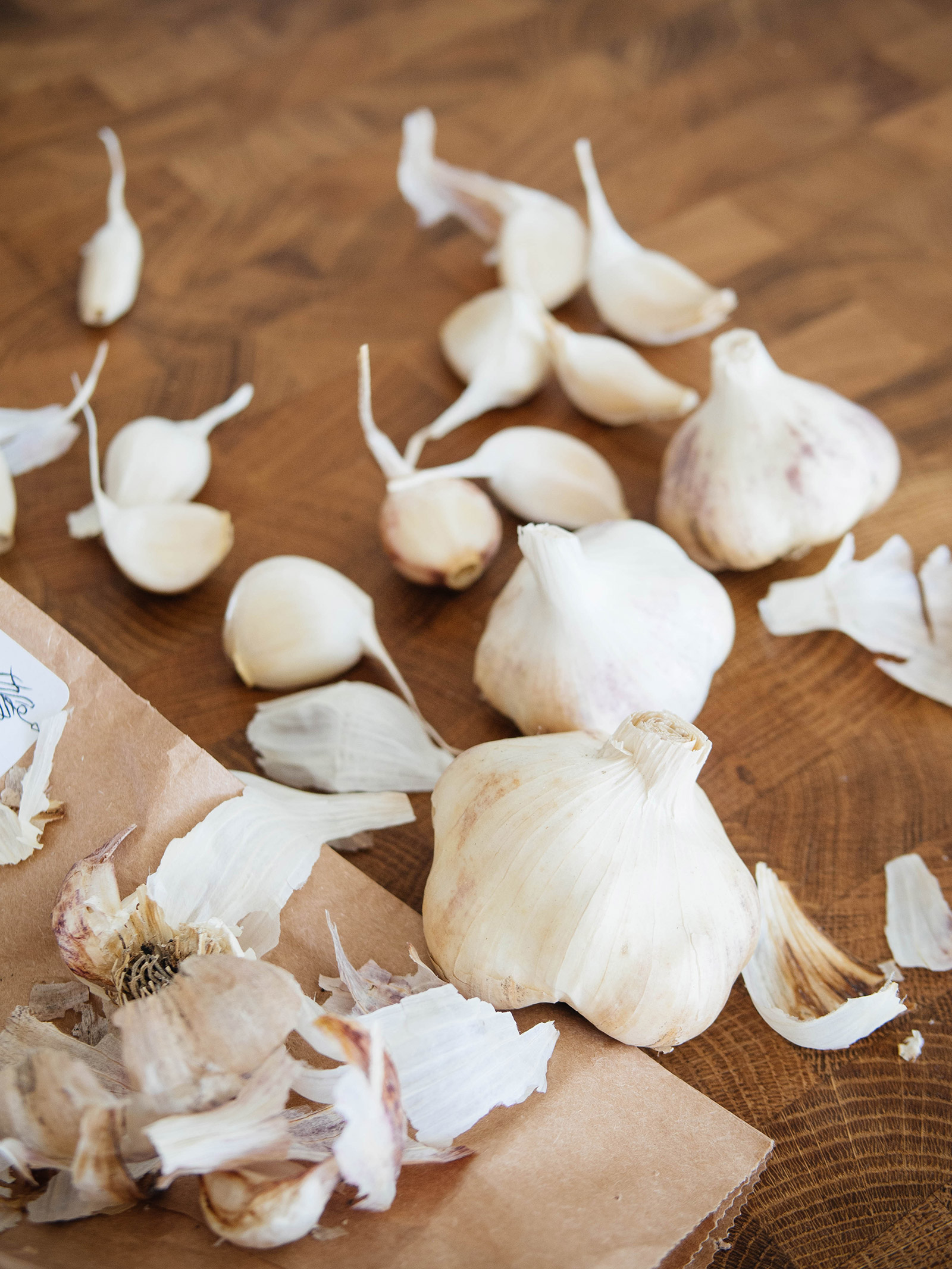













thank you! this is a great, helpful article. Came here from todays subscriptions email where you mentioned you like Music Garlic.
You’re welcome! If you have the space, I highly recommend Music. It’s so satisfying to plant, harvest, and use.